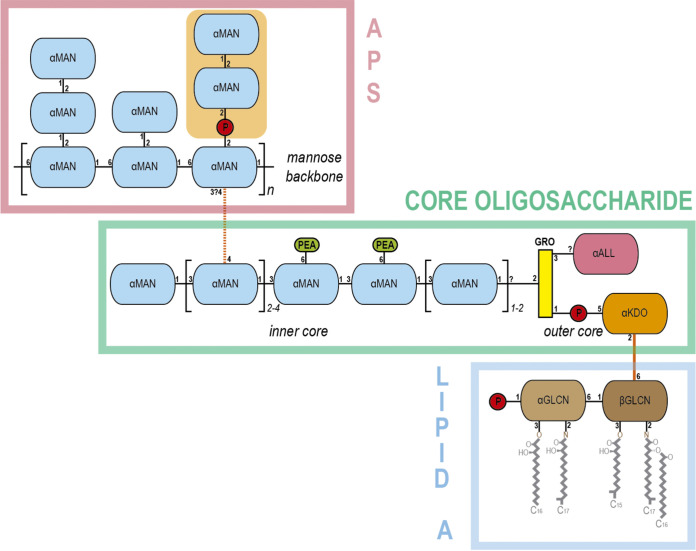FIG 1.
Anionic lipopolysaccharide (A-LPS) of P. gingivalis. A scheme depicting the modular structure of the anionic lipopolysaccharide (A-LPS) of P. gingivalis is shown. A-LPS consists of the A-type anionic distal polysaccharide (APS), the core oligosaccharide, and the endotoxin or lipid A. APS is made of an α-d-mannose (αMAN) backbone, which has side chains of one or two αMANs. One of these side chains contains the branched phosphomannan element recognized by PorZ (orange background). The core oligosaccharide spans a linear chain of αMANs that constitute the inner core. One of the monomers is linked to the mannose backbone of APS (orange dashed line). The two central αMANs of the inner core are linked to phosphoethanolamine (PEA). The inner core chain of αMANs is linked to the outer core through a glycerol molecule (GRO). The latter is linked to α-d-allosamine (αALL) and to a 3-deoxy-d-α-manno-oct-2-ulopyranosonic acid (αKDO) via a phosphate. Monomer αKDO is linked (orange line) to a β-d-glucosamine (βGLCN) from lipid A. The latter is linked to a α-d-glucosamine (αGLCN) and gives rise to the disaccharide bone structure of lipid A, which carries a phosphate and the lipids. Phosphate groups are depicted as red circles. The Δpg1142 mutant lacks an O-antigen polymerase and its A-LPS is composed of the single APS unit. The Δpg0129 mutant, in turn, affects an α-1,3-mannosyltransferase, which leads to a truncated core that lacks α-(1→3)-linked mannoses and is devoid of APS (39).

